Allion Labs
What is MagSafe?
MagSafe is a magnetic wireless power transfer standard that was first introduced in 2006 for laptops in the Mac line from Apple. On October 13th, 2020, Apple released a new version of MagSafe alongside the iPhone 12 and iPhone 12 Pro. The latest version of MagSafe can deliver up to 15W of power and is also compatible with Qi wireless charging standards. If we are to discuss MagSafe, it should be divided into two parts: MagSafe for Mac and MagSafe for iPhone.
MagSafe for Mac
MagSafe’s first appearance was at the Macworld Conference & Expo on January 10th, 2006. The power cable is fixed on by magnetic force, and in the case that someone accidentally trips over the cable, it can be safely removed from the power interface. This prevents the entire computer from being pulled off the work surface and getting damaged, greatly improving the safety of the user and the computer.
MagSafe 1
MagSafe 1 (shown in the picture below) was on the market between 2006 and 2009. The interface pin was designed to be rectangular so it could be connected to the Mabook from the front or back, also having indicator lights on both sides. The indicator shows orange when charging, and shows green when fully charged.
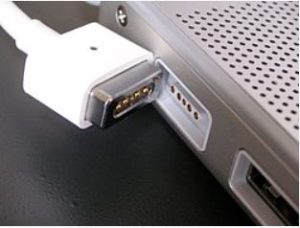
Figure 1: MagSafe 1 from 2006-2009
The L-shaped MagSafe 1 (shown in the picture below) was on the market between 2010 and 2012. The interface pin remained the same, but the outer design had been modified from a T-shaped design to an L-shaped design.
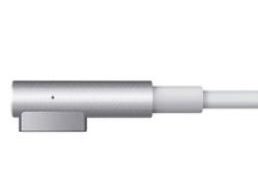
Figure 2: MagSafe 1 from 2010-2012
MagSafe 1 Power:
| Voltage | Current | Power |
| 14.5V | 3.1A | 45W |
| 16.5V | 3.65A | 60W |
| 18.5V | 4.6A | 85W |
MagSafe 2
MagSafe 2 (on the market between 2012 and 2014) was designed for the new thinner and lighter laptop, re-adopting the T-shaped design and also changing the outer casing of the connector from plastic to aluminum, as shown below:
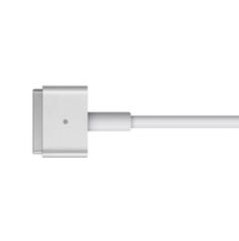
Figure 3: MagSafe 2 from 2012-2014
MagSafe 2 Power:
| Voltage | Current | Power |
| 14.85V | 3.05A | 45W |
| 16.5V | 3.65A | 60W |
| 20V | 4.25A | 85W |
MagSafe 3
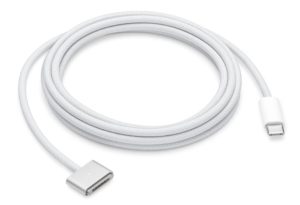
MagSafe for iPhone
In 2017, Apple introduced Qi wireless charging to the iPhone 8 and iPhone X. After 2017, the subsequent iPhones all implemented this function, but the maximum power limit was only 7.5W. Also, with Qi wireless charging, you cannot move your phone around without interrupting the charging process. To solve this problem, Apple used the same magnetic functionality of the previous MagSafe cables for the wireless charger. In 2020, it accompanied the launch of the iPhone 12, introducing a new generation of the MagSafe charger specially designed for iPhone, as shown in the image below:
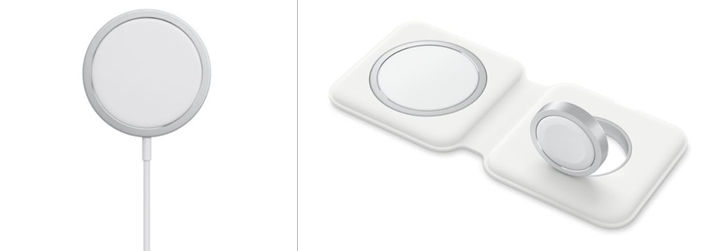
Figure 5: MagSafe for iPhone
All iPhone models after the iPhone 12 have utilized MagSafe technology. Apple uses electromagnetic induction to change the magnetic field within the charger, driving the flow of electrons to generate a rechargeable current. A magnet array is added around the charging coil inside the mobile phone, ensuring the MagSafe charger is accurately fixed in the correct position and not easily displaced. This also increases the maximum charging power from 7.5W to 15W. Apple also added a Nanocrystalline panel and two sensors to increase the sensitivity of the induced magnetic field, improving the design of the E-shield, which makes charging your phone even safer (shown in the picture below).
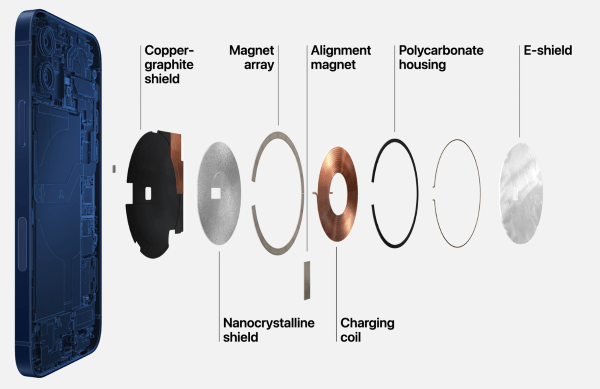
Figure 6: MagSafe for iPhone Design
Differences between Qi wireless charging and MagSafe:
| Qi | MagSafe | |
| Maximum Charging Power | 7.5W | 15W |
| Magnetic | No | Yes |
| Note | The current 1.3 version of Qi wireless charging already supports 15W charging, but the iPhone does not support the latest version. | |
What Do “Made for MagSafe (MFM)” and “MagSafe Compatible” Mean?
MagSafe, a patented technology made by Apple, can effectively solve the problem of wires tangling together during usage. It’s currently widely adopted in protective cases, chargers, mobile power supplies, and card holders. The MFM certification is similar to Apple’s previous Made for iPhone (MFi) certification. Third-party accessory manufacturers needed to pass Apple’s strict review to obtain their certification.
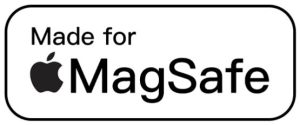
Figure 7: Made for MagSafe Certification
The MFM-certified charging devices are able to provide the iPhone with a 15W charging power and will trigger a special animation when charging.
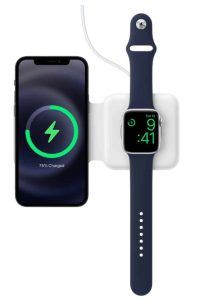
Figure 8: MagSafe charger for iPhone and Apple Watch
Because MagSafe for Mac has fewer products and is monopolized by Apple, Allion has mostly conducted comparative experiments on MagSafe and MagSafe Compatible chargers for mobile phones on the market. Below, we show three MagSafe charger experiments that compare the charging performance of different MagSafe chargers, and we recorded the charging time from 0% to 100% with different MagSafe protective cases.
| Model | Apple iPhone 12 Pro
Version: iOS 15.6.1 Battery Capacity: 2815mAh |
| MagSafe Charger | Apple MagSafe Charger
FW Version: 255.0.0.0 |
| MagSafe Compatible Charger | Brand “B”
FW Version: None |
| Brand “White”
FW Version: None |
|
| Power Adapter (All three chargers are connected to this adapter) | Apple Type-C Charger (20W) |
| MagSafe Protective Case (MFM) | Apple Silicon Protective Case |
| Brand “O” Silicon Protective Case |
| Charger | Charging Time (Minutes) | ||
| With No Case | Apple | Brand “O” | |
| Apple | 216 | 166 | 173 |
| Brand “B” | 252 | 176 | 180 |
| Brand “White” | 222 | 277 | 333 |
Looking at the charging time, Apple’s MagSafe charger had a significantly shorter time than the Brand “B” MagSafe Compatible charger, but it is almost the same as Brand “White”. As you can see, the Brand “B” charger is not able to fast charge the phone at 15W without a case, dropping down to 7.5W.
Because the MagSafe wireless charger can also charge other brands of phones, Allion also used an Android phone (Samsung S9) that supports wireless charging and has a similar battery capacity to the iPhone 12 Pro for the experiment. We used the same Apple Type-C Power Adapter with the MagSafe Charger to measure the charging times.
| Model | Samsung Galaxy S9
Version: Android 10 Battery Capacity: 3000mAh |
| MagSafe Charger | Apple MagSafe Charger
FW Version: 255.0.0.0 |
| MagSafe Compatible Charger | Brand “B”
FW Version: None |
| Brand “White”
FW Version: None |
|
| Power Adapter (All three chargers are connected to this adapter) | Apple Type-C Charger (20W) |
| MagSafe Protective Case (MFM) | Apple Silicon Protective Case |
| Brand “O” Silicon Protective Case |
| Charger | Charging Time (Minutes) | ||
| With No Case | Apple | Brand “O” | |
| Apple | 220 | 200 | 195 |
| Brand “B” | 323 | 170 | 169 |
| Brand “White” | 191 | 318 | 225 |
Testing and Services for MagSafe and MagSafe Compatible Chargers
- Compatibility Test
- Functionality Test
- Durability Test (Stability Test)
- User Experience Test
- Competitive Analysis and Consulting






































